As promised, here’s our little interview with artist Nicholas Galanin, compiled from questions from Holland members who have gotten to spend some good time over the past couple months with some of his pieces that are up now as part of the Nevada Museum of Art’s Unsettled exhibition, and a few from those who caught him at A+E Conference a couple weeks ago.
For those that have poked around the NMA, you’ll recognize the featured exhibition image – Galanin’s iconographic Things are looking Native, Native’s looking Whiter depicting a Hopi-Tewa girl on one side (as photographed in 1906 by Edward Curtis), juxtaposed + mashed up with the press shot of Carrie Fischer as Princess Leia from 1977’s Star Wars IV (photo below). It’s an impactful and in-your-face comment on cultural appropriation in popular media (a little more context here). Video pieces titled Tsu Heidei Shugaxtutaan 1 & 2 (We Will Again Open This Container of Wisdom That Has Been Left in Our Care) are the first thing you’ll see and hear when you step foot inside the museum – they’re running on a loop above the entrance desk. In Part 1, Galanin directs a performer wearing street clothes in an open, modern room, dancing to traditional music. In the next, which plays directly after, the performer wears traditional robes and mask against a background of totem animal imagery and moves to techno. Fuzzed out screen shots, in addition to the actual videos, are below. Additional Galanin pieces in Unsettled include No Pigs in Paradise, a mixed media gown done in collaboration with Nep Sidhu (photo below) and Your Inane Perspective: Haa AanÍ Haa Kusteeyíx̱ (Our Land is our Life) – a piece that focuses on themes of erasure and language (photo also below, with the question that highlights this topic).

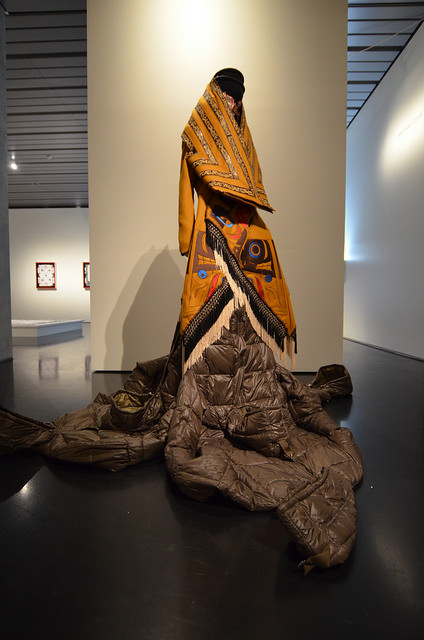
No Pigs in Paradise, 2016. Nicholas Galanin & Nep Sidhu
For some more about Nicholas, we recommend checking out this 10.26.17 article from Seattle’s City Arts Mag – Renaissance Mountain Man. You can also follow him on Instagram and Twitter at @silverjackson. His Flickr page is worth a peek-through too, and his site’s HERE for updates and more information. NOW, check out his responses to some our Q’s below!
NICHOLAS GALANIN | HOLLAND PROJECT
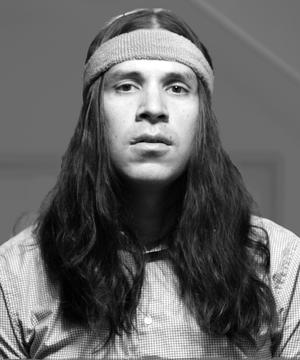
Q: You’ve been cited as part of a generation of artists and performers that is ‘redefining native’ – what does that mean to you?
I think this term is for those who have romantic or stereotypical ideas on what Indigenous culture might be. In that case, yea let’s redify…. redefine it.
Q: How does tradition play into the work you make? Do you have rules or boundaries about when to honor certain traditions, and when to play with, bend, break, or modernize them?
Tradition is continuum and change. My foundation is built on aspiring to contribute to the culture, to hold it and contribute something meaningful and necessary, to learn and listen from the ancestors, the land. Work that some might consider bending or breaking is also part of this continuum, created out of necessity.

Things are looking Native, Native’s looking Whiter, 2012
Q: Much of your work deals with the intersection of culture vs culture – Culture 1: your history, ancestry and heritage and Culture 2: American pop and mainstream culture – past and present. Can you talk about this?
I am not putting culture vs culture onto a collision path, this work is all rooted from the same space. The viewer will often separate and catalogues it this way out of laziness.
Q: What are the issues, in your own work or otherwise, that are most important to you?
Valuing & loving culture, land and sea. Indigenous sovereignty.

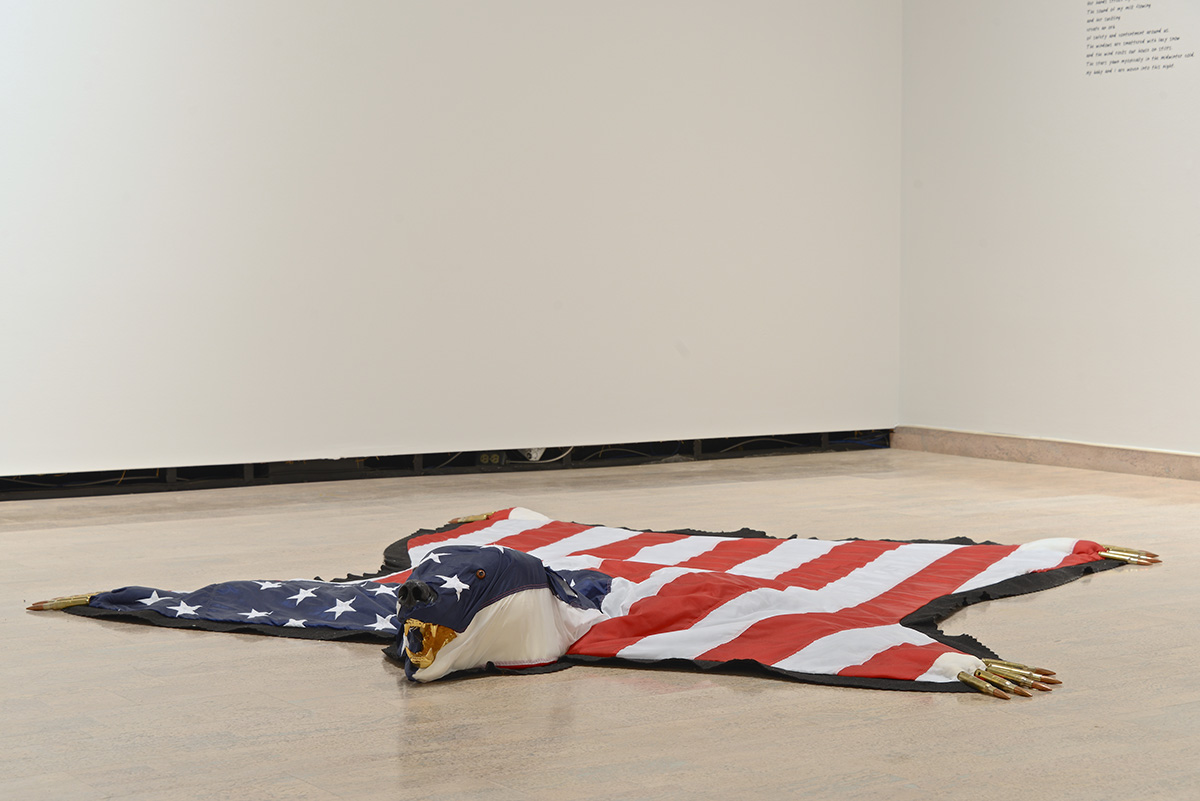
The American Dream is Alive and Well, 2012
Q: You are very rooted in your community, but have a pretty big international perspective (you’ve studied, lived and shown abroad, you collaborate with other artists from diverse regions/communities and countries). How does this wider perspective impact you or your work?
Perspective is important, I feel fortunate to sit and share space with some of the brightest minds. Diversity is important, don’t live your life in fear of the other.
Q: In collaboration, do you find there’s a lot of commonality and shared experience, or that it’s outsider status and perspective that’s the most interesting part of collaborative projects?
There certainly is commonality in experience in collaboration. Collaboration also offers diverse insight into how we communicate through visual work. I am grateful to have had the opportunity to collaborate with some incredible artists. Collaboration allows for movement and composition much like having harmonies in song or dance partners on the floor.
Q: Words are important, as is language. Your work and exhibitions have powerful titles, you’re a songwriter and performer, and some of your pieces talk about naming. You talked a bit about how indigenous place naming was rooted in description – names had knowledge, insight, relationships, cues, and information. Can you share more about place names, what happened when names were replaced by settlers and colonizers, and in general how you think about or use words and language – as poetry, art, and statement.
Words are important. The colonial genocide of Indigenous culture was very thorough, but we are resilient. Our Indigenous languages provide deep insight into a special relationship to land & space. Settler naming contains none of this, let’s look at the recent example of the dotard who promised and recently offered to change Denali back to Mckinley. Erasure attempts are still happening today.
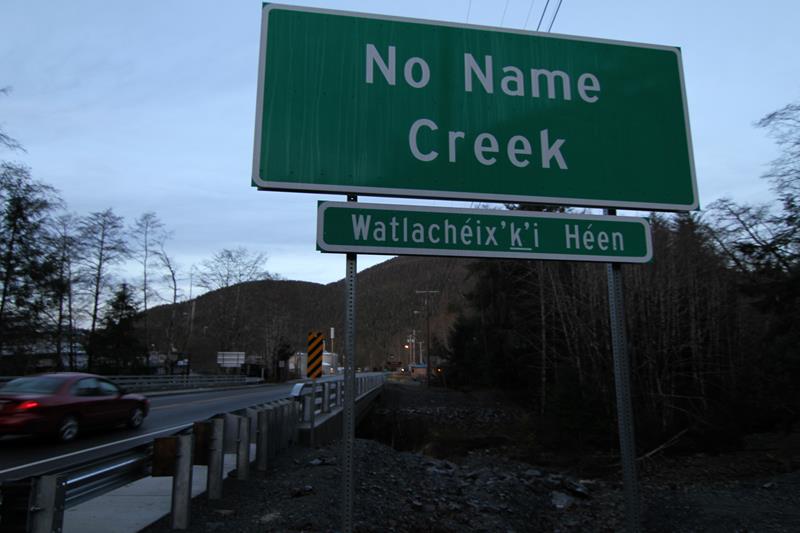
Your Inane Perspective: Haa AanÍ Haa Kusteeyíx̱ (Our Land is our Life), 2015
Q: In your panel discussion, you said something that really resonated. You mentioned, that the majority of exhibitions you are asked to participate in have a theme based in “identity,” and you said poignantly, “but I know who I am.” Holland Project has a show up now, with an identity theme, and has had others in the past. Why is this problematic, or too easy, or how should the thinking be shifted in this?
It is perspective based and tiring to circle in this space when you can instead look closely or clearly at the deeper more meaningful conversations we are having. We are not trends.
Q: Recently, we’ve been having an ongoing discussion about “navigating white spaces” – especially in an art or institutional realm. Young people are pushing hard for the breaking down of these barriers – to be active and respected participants and fully representative in places that have been both subtly or overtly discriminatory for very long periods of time. Can you talk about your experience as a young artist, a native man, and someone who’s had to navigate these waters?
It’s been continual work, from the first time I had realized that I was not allowed to bring my culture into certain Institutional space. Sometimes it’s best to avoid the space as a whole, cultural work is not always meant for those spaces. Bridging community in institution has been ongoing work, though it is slow moving forward. Sometimes you have to wait for these spaces to catch up. Until then, I say teach the youth and community, outside & inside these white spaces. It’s the children that are often free in the mind, free in the heart to understand and see more then a parent set in his or her old way.

I Think it Goes Like This, 2012
Q: Do you have a piece of advice you’d like to give to young artists or creators?
Keep it moving, keep your knives sharp too. Don’t be afraid to address and offer space for dialogue with conversations in community that contribute towards progress. Take care of the environment. Learn to love to listen, sleep & drink more water… also check out our new album www.indianagent.bandcamp.com
Q: On the environmental and social justice front, some major issues affecting native and indigenous communities have been at the center of the battleground and in the media this past year – water, food, pipelines, climate change, land use. Politically and socially, what are your primary fears and concerns, and where do you think the attention/action is most important?
These absolutely are not just Indigenous community issues, these are everyones issues. With that mind frame alone, you may be part of the problem. Action across the board is equally important here, societies water & sustenance is becoming toxic along with violence towards land. Our children are faced with the necessity to survive and care for the land, water & sea, what will you do?
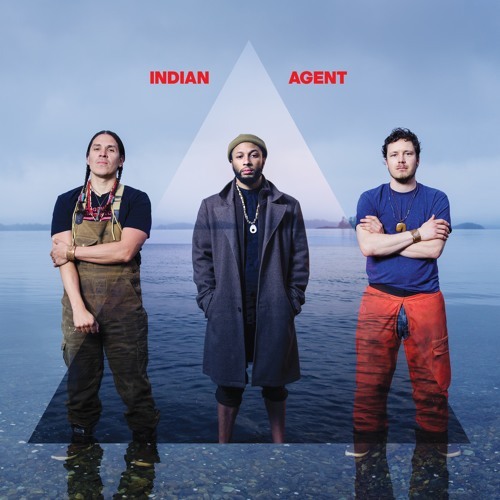
Q: Tell us about your connection to the Seattle music community, and the process of your band, Indian Agent, getting a release on Sub Pop Records?
I used to host a music festival in Sitka for ten years called HomeSkillet Fest, there I met some incredible friends and musicians, many of these artists came North from Seattle to perform. I met Jonathan Poneman at an art exhibition I was part of in Seattle. My friend Skin introduced us, and we had become friends since. Jonathan heard some of the albums I’ve been releasing on my independent record label Home Skillet Records. I sent him the new Indian Agent Bandcamp record and that’s a wrap. Sub Pop will distribute the physical double LP on vinyl for us, which an honor for sure. An incredible opportunity.
Q: What are some projects or who are some people you’d like to shout out? Things you’re digging or people doing cool or important stuff?
Shout to the Black Constellation and Erin Joyce.
I have several projects coming up, including a tour in Europe early 2018. A new solo exhibition at a museum (not public information yet), a new monograph book hitting the press soon — which will include a 7″ record with new unreleased Indian Agent songs.
I’m carving a 40ft totem pole right now and training 5 apprentices on the project. In the 60’s a Tlingit village was burnt down to clear space for a harbor… this pole is a healing pole that acknowledges that this is still Tlingit territory and land. [Read: Forgiving without Forgetting: A Tlingit Village Up in Smoke].
I’ll also be heading to the Bellagio Center in Italy next year to collaborate with Adrian Matejka as recipients of the Rockefellar Foundation Fellowship. I am partially through an NACAF Mentor Apprentice Fellowship where I get to mentor artist Sam Sheakley, teaching metal working, chasing and repouse.
I have the honor of being University of Alaska Southeast’s first artist in Residence, where I will teach some courses and assist in the development of their Indigenous Arts program.
Q: Any parting words?
Gunalchéesh
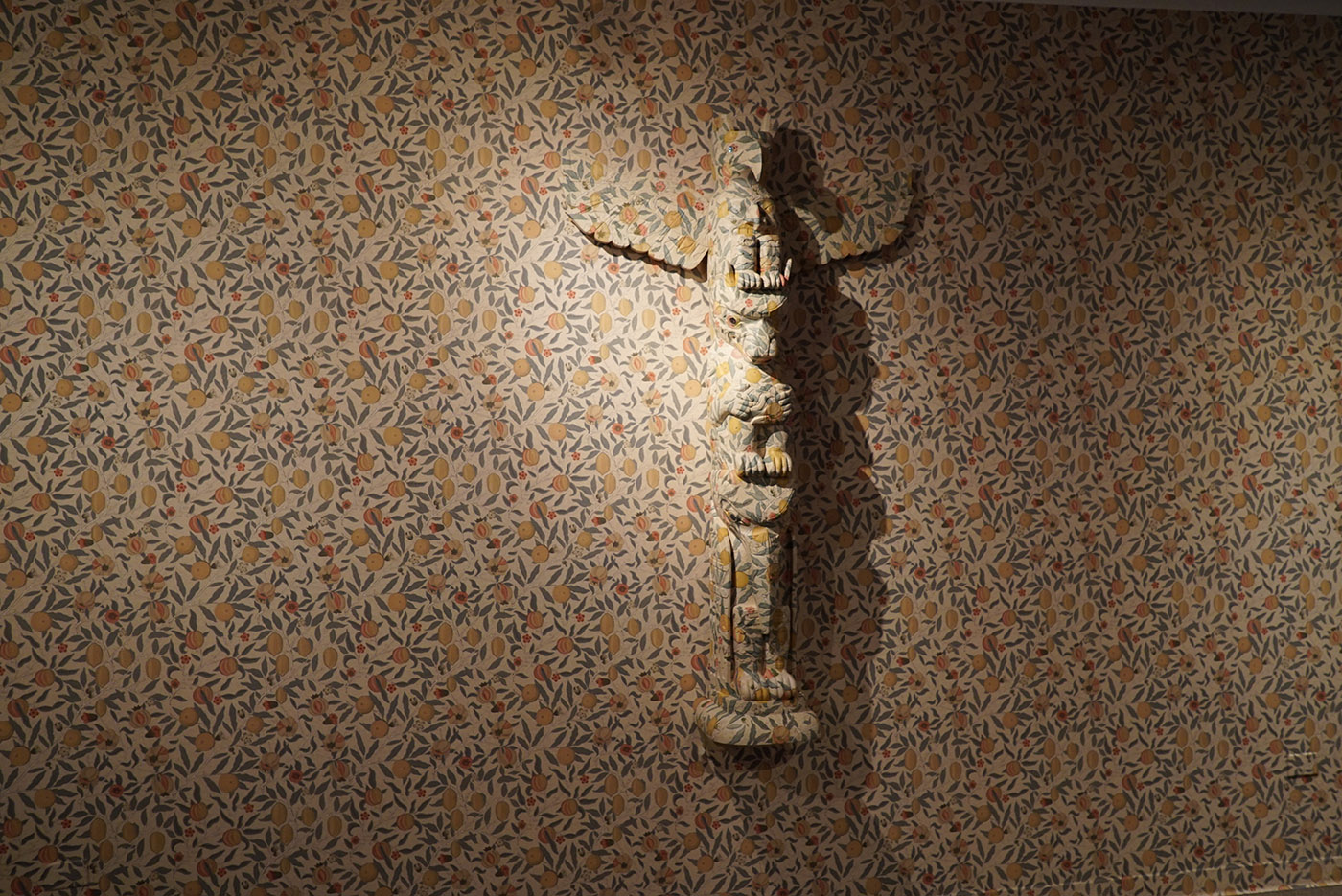
The Imaginary Indian, 2016. Nicholas Galanin ^
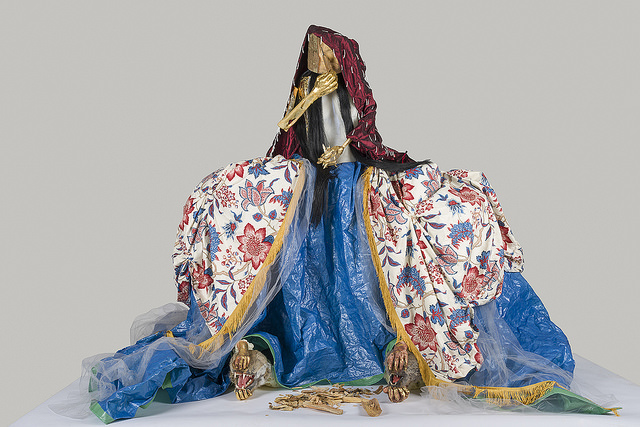
^ Creation with her children, 2017. Nicholas Galanin & Merritt Johnson

Get Comfortable, 2014. Nicholas Galanin ^
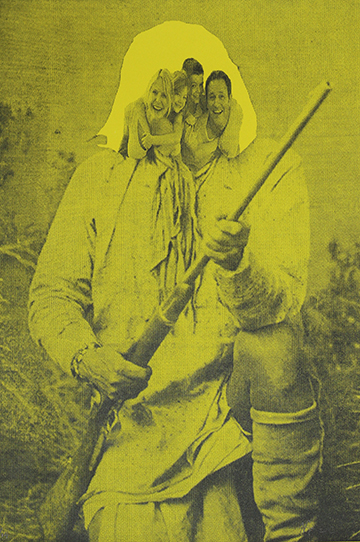
^ Operation Geronimo, silkscreen, 2013. Nicholas Galanin
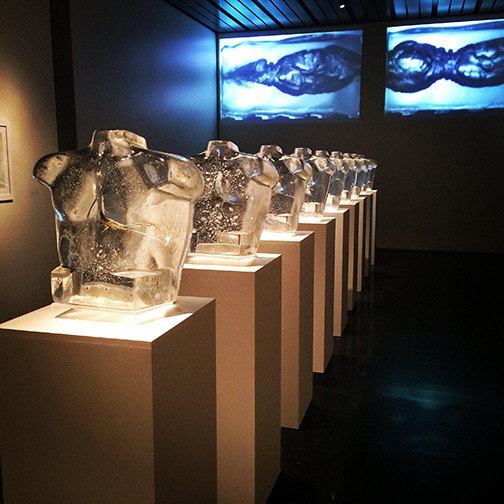
A Supple Plunder. Leonardgetinthecar, 2015. Nicholas and Jerrod Galanin ^
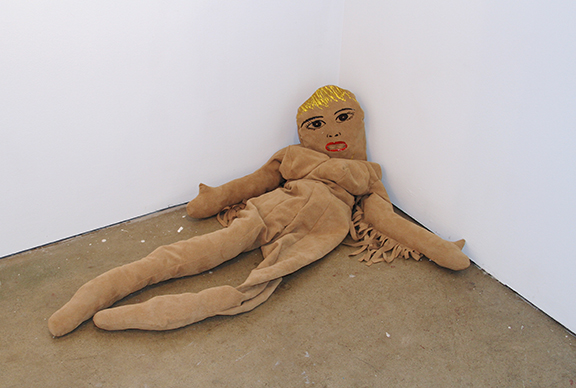
^ I Looooove Your Culture! Beautiful Leather Craft, 2012. Nicholas Galanin
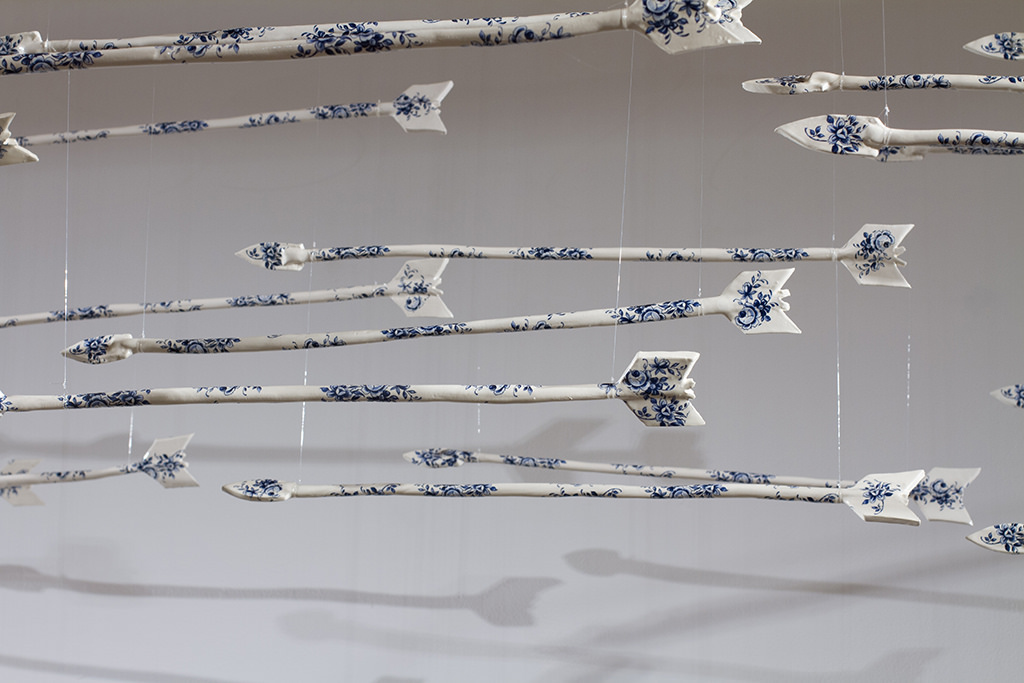
I dreamt I could fly, 2013. Nicholas Galanin ^

^ Indian Children’s Bracelet, 2014. Nicholas Galanin

We Dreamt Deaf, 2015. Nicholas Galanin ^
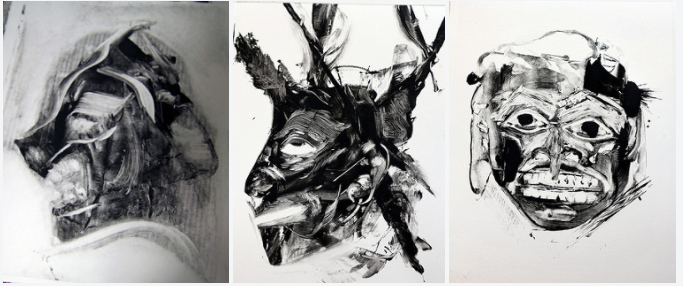 ^ Familiar Faces 4, 2 and 3, monotypes, 2013. Nicholas Galanin
^ Familiar Faces 4, 2 and 3, monotypes, 2013. Nicholas Galanin
